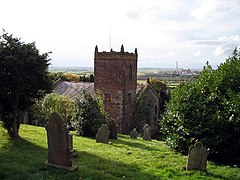South Ferriby
| South Ferriby | |
|---|---|
 St Nicholas' Church, South Ferriby |
|
| South Ferriby shown within Lincolnshire | |
| Population | 651 (2011 census) |
| OS grid reference | SE987210 |
| • London | 155 mi (249 km) S |
| Unitary authority | |
| Ceremonial county | |
| Region | |
| Country | England |
| Sovereign state | United Kingdom |
| Post town | BARTON-UPON-HUMBER |
| Postcode district | DN18 |
| Dialling code | 01652 |
| Police | Humberside |
| Fire | Humberside |
| Ambulance | East Midlands |
| EU Parliament | Yorkshire and the Humber |
| UK Parliament | |
South Ferriby is a village in North Lincolnshire, England. It is situated on the south bank of the Humber Estuary and 3 miles (5 km) west from the Humber Bridge. North Ferriby is directly opposite on the Estuary’s north bank. Village population was 651 in 2011.
South Ferriby dates back at least to Roman times when there was a major settlement. It is known locally as one of the 'Low Villages' at the bottom of a chalk escarpment, where the chalk meets the clay to give, before piped water,(the village was one of the first to have piped water with houses plumbing into the supply which was put down to supply steam ships) to the a plentiful water supply. It also marks the point where the Lincolnshire Wolds meet the Humber Estuary and was, as the name suggests, the southern end of an ancient ferry over the Humber to North Ferriby. The entry in the Domesday Book of 1086 records a church, a mill and two ferries. To sustain two ferries suggests that a prosperous trading community must have been flourishing at the time.
South Ferriby was once two villages, Ferriby Sluice with its strong connection to brick manufacture and other activities on the River Ancholme and South Ferriby with two farms that are still operational. The village has a general store with post office, garage, primary school and two public houses:(one public house The Nelthorpe Arms shut 2016) the Nelthorpe Arms, named after the family who at the beginning of the 19th century owned over half the village (and still have major holdings today) and down by the Sluice, the Hope and Anchor which looks out over the Humber with Read's Island and its wildlife.
The parish church, dedicated to St Nicholas, appears to be the remnant of a much larger church; it is a structure consisting of nave, south transept, north porch and an embattled tower with pinnacles at the south-east corner containing 3 bells. Over the porch is an ancient semicircular stone, on which is a sculptured figure of St Nicholas, vested in alb and mitre and holding a pastoral staff in his left hand and on either side are symbolical figures of the Sun and Moon. The unusual north-south alignment of the current church is a legacy of a Victorian enlargements of the church. The Creed and Commandment boards survived in the vestry in the 1990s, and the present pulpit is a surviving element of the 18th century two- or three-decker pulpit dismantled during the 1870s reordering of the church. This was the chancel prior to the 1870s, the nave of the church having been rebuilt almost square following a landslip in the late 16th century.
...
Wikipedia

